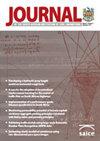地方政府层面联合用水的随机日时间步长模型
IF 0.6
4区 工程技术
Q4 ENGINEERING, CIVIL
Journal of the South African Institution of Civil Engineering
Pub Date : 2022-09-14
DOI:10.17159/2309-8775/2022/v64n3a3
引用次数: 0
摘要
南非拥有广泛发展的水资源基础设施,主要基于地表水、局部地下水和有限的海水淡化。水和卫生部预计,到2025年,不断增加的需求将超过该国散装供水系统的容量。为了缓解地方当局层面的缺水问题,需要研究更多的联合用水解决方案。为地方当局更好地管理供水系统,开发了一个Microsoft Excel 2016模型,用于每天估计供水能力。该模型利用基于历史数据综合生成的随机径流序列。将月径流分解为日径流,并建立降雨-径流关系,生成合成降雨序列。地下水采用类似于含水层公司产量模型的方法进行建模。补给百分比(降雨量数据)来自地下水资源评估第2阶段项目。库伯-雅各布模型评估了钻孔下沉及其对周围钻孔的影响。海水淡化和水回收被建模为一个来源。该模型评估和比较了不同运行场景下联合使用供水系统的历史可用水量和随机可用水量。Stellenbosch的供水系统被用作案例研究,以说明该模型的功能。本文章由计算机程序翻译,如有差异,请以英文原文为准。
A stochastic, daily time-step model for conjunctive water use at local authority level
South Africa has a broadly developed water resource infrastructure, based mainly on surface water, localised groundwater, and limited desalination. The Department of Water and Sanitation projects that increasing requirements will exceed the capacity of the country's bulk water supply systems by 2025. To mitigate water scarcity at a local authority level, more conjunctive water use solutions need to be investigated. A Microsoft Excel 2016 model, estimating supply capacity on a daily basis, was developed for local authorities to better manage their water supply systems. The model utilises synthetically generated stochastic streamflow sequences, based on historical data. Monthly streamflow is disaggregated into daily streamflow and a rainfall-runoff relationship is established to produce synthetic rainfall sequences. Groundwater is modelled using an approach similar to the Aquifer Firm Yield Model. Recharge percentages (rainfall data) are obtained from the Groundwater Resource Assessment Phase 2 project. The Cooper-Jacob model evaluates borehole drawdowns and their effect on surrounding boreholes. Desalination and water reclamation are modelled as one source. The model evaluates and compares the historical, as well as stochastic available yield of a conjunctive use water supply system, for different operational scenarios. The water supply system of Stellenbosch was used as a case study to illustrate the model's functionality.
求助全文
通过发布文献求助,成功后即可免费获取论文全文。
去求助
来源期刊
CiteScore
0.70
自引率
25.00%
发文量
19
审稿时长
>12 weeks
期刊介绍:
The Journal of the South African Institution of Civil Engineering publishes peer reviewed papers on all aspects of Civil Engineering relevant to Africa. It is an open access, ISI accredited journal, providing authoritative information not only on current developments, but also – through its back issues – giving access to data on established practices and the construction of existing infrastructure. It is published quarterly and is controlled by a Journal Editorial Panel.
The forerunner of the South African Institution of Civil Engineering was established in 1903 as a learned society aiming to develop technology and to share knowledge for the development of the day. The minutes of the proceedings of the then Cape Society of Civil Engineers mainly contained technical papers presented at the Society''s meetings. Since then, and throughout its long history, during which time it has undergone several name changes, the organisation has continued to publish technical papers in its monthly publication (magazine), until 1993 when it created a separate journal for the publication of technical papers.

 求助内容:
求助内容: 应助结果提醒方式:
应助结果提醒方式:


